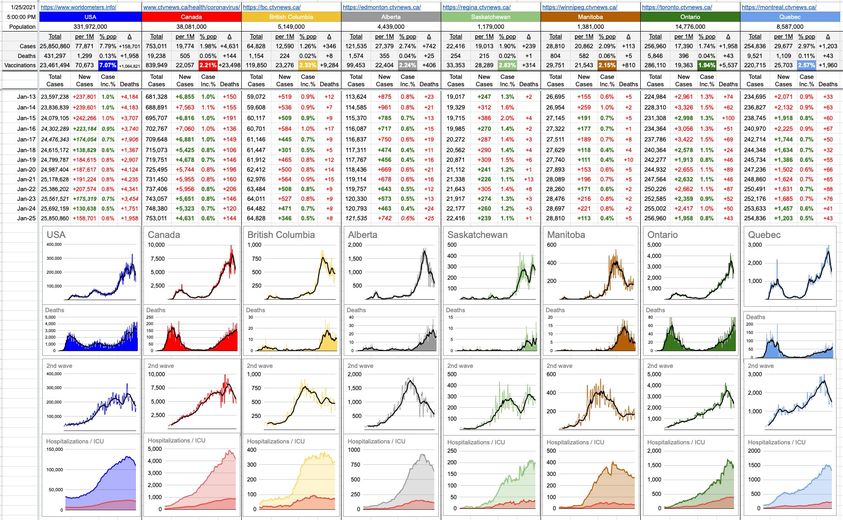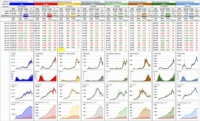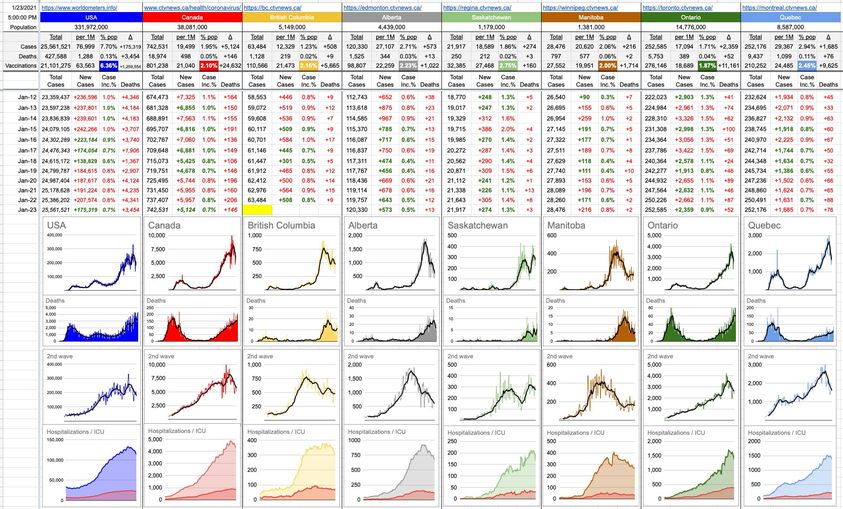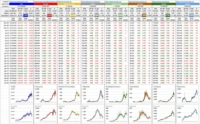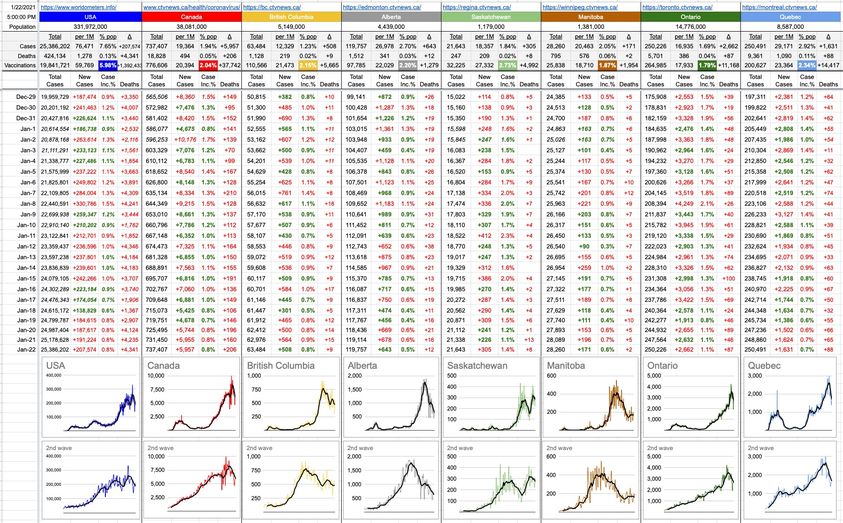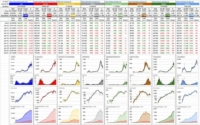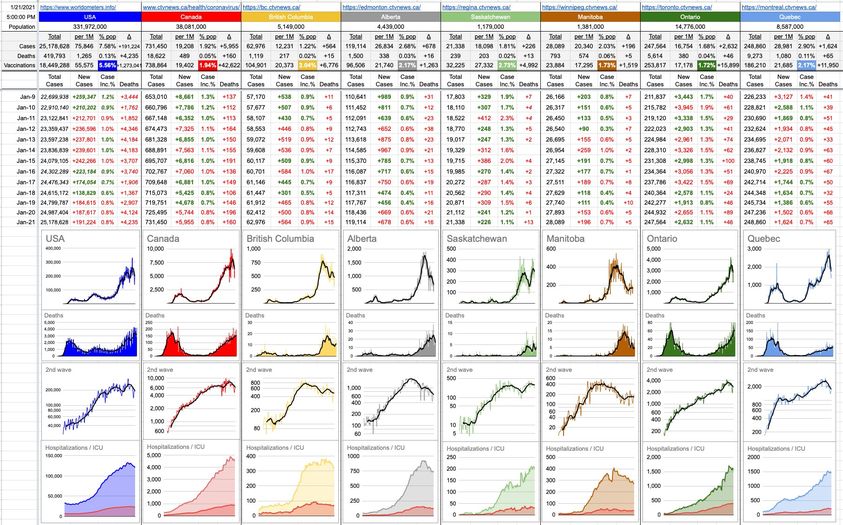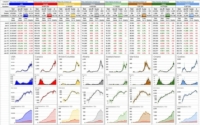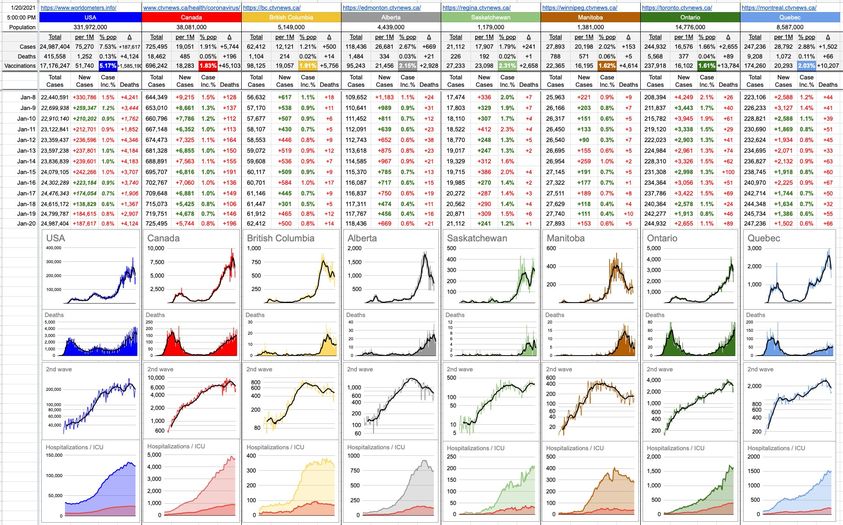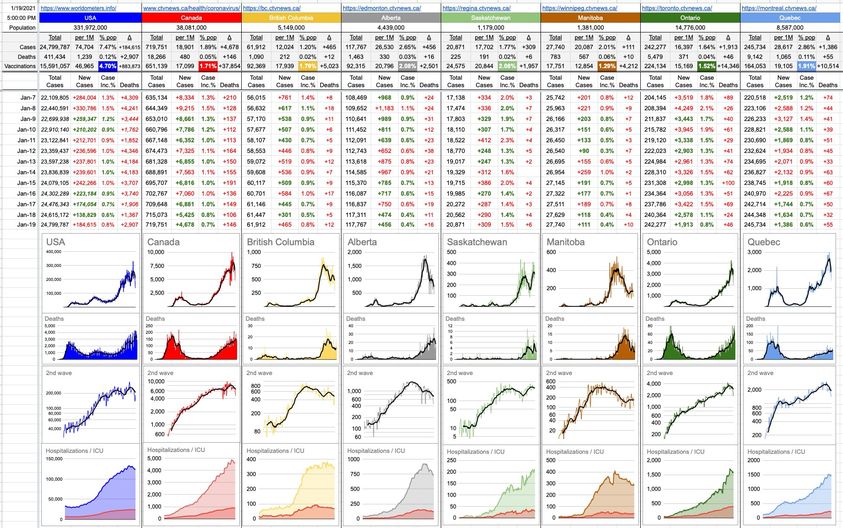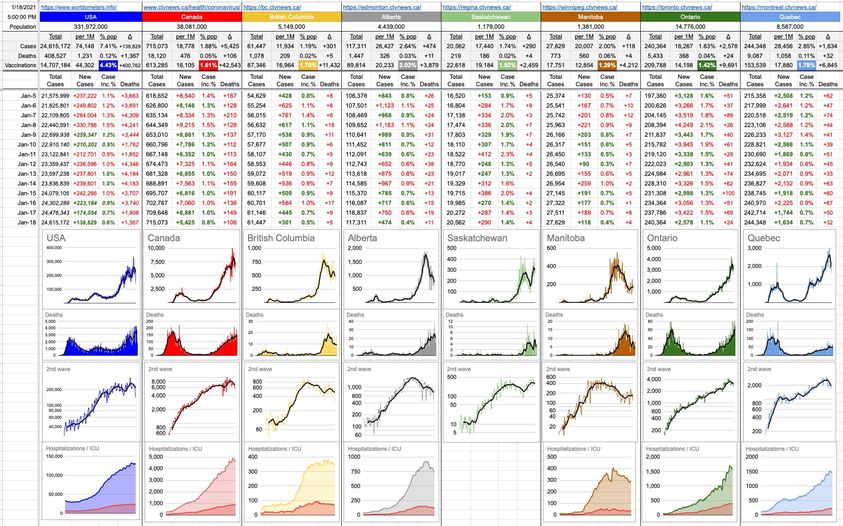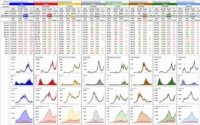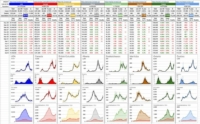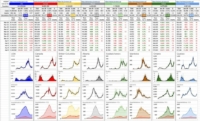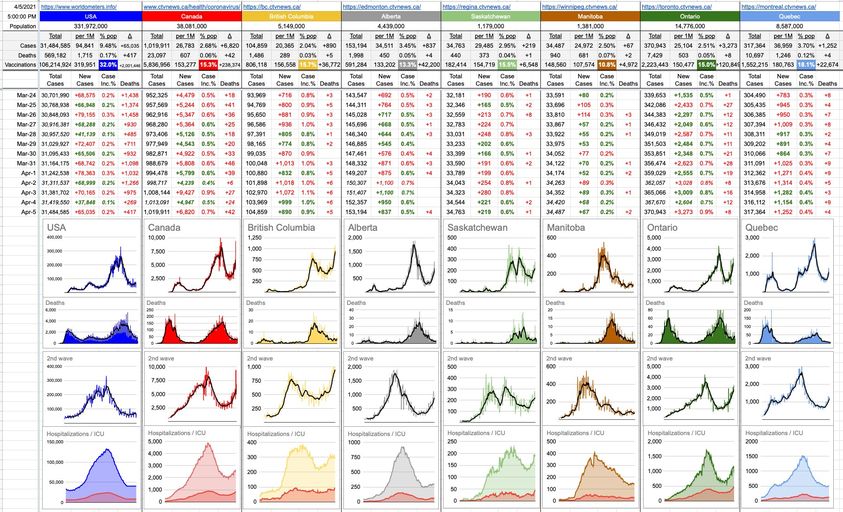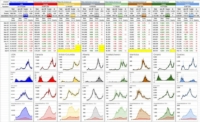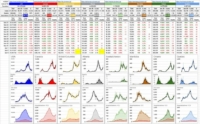January 25, 2021
A year ago today, a man who’d recently returned from Wuhan, China, wasn’t feeling well… and wound up at Toronto’s Sunnybrook Hospital, where he became Canada’s first test-positive C19 case.
Hearing that this morning made me think back… what was I doing at the time? Thanks to modern technology, it doesn’t take much to scroll back through recent history.
A year ago last night, I was at the Chan Centre watching my talented nephew, acting in a very engaging and entertaining theatre production. It was excellent, and so, appropriately, the venue was jammed.
A year ago today was a Saturday, and, at 10am, we were back at UBC — at TRIUMF this time — for a couple of lectures. One was about earthquakes – the famous impending “big one” that will hit the south coast, sometime between tonight and 500 years from now. The other was about black holes, cosmic collisions and sensing gravitational waves. Takeaway: If a large earthquake shows up off the south coast, don’t be in Tofino. And, I guess, if a black hole shows up off the south coast, don’t be in Tofino either… but you won’t have much too time to worry about it.
These lectures are super-interesting if you’re into this sort of thing, so, accordingly, it was crowded. Sold out in fact. So sold out we couldn’t get tickets online, and just crashed the venue, hoping we could sneak in. The tickets are free, but seating is limited; fortunately, some people didn’t show up and they let us in.
The kids were there too, and perhaps it took a bit of gentle bartering to get one of them there as well, because we wound up going out for dinner that night, to Kobe. Kobe is excellent, and always crowded as well; you end up sharing a table/cooking surface with complete strangers for a couple of hours.
Talk about taking stuff for granted. Three very different things, but all had one thing in common; hanging out in close proximity with strangers… and thinking nothing of it. That’s how it was.
So, what’s happened in that one year… today also marks another milestone; today, the world went over 100,000,000 known C19 cases. There have been over 2,000,000 deaths. There have also been over 72,000,000 recoveries. In Canada, more than 750,000 cases came after that guy.
My prediction was that here in Canada, we’d be seeing the worst of this pandemic… right about now. Now would be the time when the gradual decline would begin, and while it’d take a long time to snuff it out in due course, it’d never get worse than what we’re experiencing now.
This completely-non-professional opinion was based on the confluence of a few things, but primarily, it’s this: any negative effect that would’ve been caused by the holiday season would now be known and we’d be in the midst of handling. Whether they were supposed to or not, people got together over the holidays. Some of them passed on infections, etc… so how bad was it? Well, it definitely caused a spike, but if you look at the graphs and numbers, things are clearly trending favourably. Couple that with the fact that there are no large family-gathering-type holidays any time soon… and given that vaccines are every day making slow but steady progress into bloodstreams… and that the majority of people and businesses are still towing the party line… put it all together and, optimistically, the worst is behind us. That being said, who could’ve predicted newer mutations that are more virulent, and which could possibly lead to more cases. The answer to that question is epidemiologists… and they did.
We’re far from sounding the all-clear, but the numbers and pictures at the moment tell a cautiously-optimistic story; declines everywhere… ranging from steep (Alberta, Manitoba, Quebec) to moderate (B.C) to mild (Ontario, Saskatchewan)… but the entire country is trending in the right direction. For now.
Today’s versions of cool lectures, theatre productions, and restaurants look nothing like what they did a year ago. There are online and socially-distanced versions of all of that, but they’re nothing like the real thing. A year ago we had the real thing… and every indication is that a year from now, we’ll have it again.
34 Likes, 4 Shares
January 24, 2021
Weird things happen when you’re dealing with big numbers, but when you get to them slowly. Here’s a very basic example, speaking purely with respect to financial wealth:
A man whose net worth is only $1 is not rich. Far from it. Let’s call him poor.
If you take a man who’s poor and give him $1, he’s still poor.
Given those two starting premises, start a little loop. Give the guy another dollar. Is he rich now? No. $3? No. $4? No. But you loop a billion times, and of course, now he is. Somewhere along the line, he went from being poor to being stable… and, continuing, at some point he went from being stable to being well-off. Then he graduated to financially secure… on his way to rich. A dollar a time, he crossed all those lines.
The thing is… it’s difficult to figure out where to draw those lines, because they’re big, wide and blurry. And I don’t mean because everyone would have different definitions and opinions. I mean just you. Pick a number where you’d consider the guy to be unarguably in one of those categories. Now think of a number that’d plant him squarely in the next category up. Those two numbers are far apart. Even if you try to bring them closer together, you’ll still never get to a point where it flips by $1.
This same concept is what plays with our minds in elections. What difference does my one vote make? We keep getting told that it makes all the difference; every vote counts, etc. But the truth is… all other things being equal, your one little vote doesn’t matter. It’s quite a paradox. Take the last election, wherever you are. Change nothing except your one vote… remove it from the election. Did that change anything? Of course not. But also, of course, everything changes if more people start thinking like that. Many elections went the other way (Hilary 2016 comes to mind) because so many people become convinced that their one little vote wouldn’t matter (like people in Michigan) that they didn’t bother voting. At some point, even though it got there one missed vote at a time, it made a difference.
I’ve been accused of being a bit preachy and/or being a little shame-bashing on those making some individual decisions based on how they’re navigating their lives these days; choices with which I don’t agree with, with respect to travel or socializing or whatever… let alone masks and vaccines… but the intent of this post is not that. I’m just here to share a thought… reflecting on how we suddenly hit tipping points where everything changes… and how we got there.
Most rags-to-riches stories are long and drawn out; tiny, incremental gains over long periods of time. Perhaps not dollar-by-dollar, but it’s not a fine line that was hopped over one particular day.
Similarly, it’s like that with a pandemic. I look at these numbers every day, and there’s micro-movement in some direction. On a day-to-day basis, it doesn’t seem to matter much. But when you take a step back and look at it from a bigger-picture point of view, one day you realize you’re in a totally different place. These days, that looks a lot better than it did just a few short weeks ago. But it’s worth remembering how we got here, and how we’ll get to wherever we’re going next… one dollar or one step or one person… at a time.
21 Likes, 3 Shares
January 23, 2021
We watched a movie the other night… I thought it’d be a waste of time, but the kids really wanted to see it. OK… I can spare an hour and forty minutes, and who knows… it might be amusing. It’s called “Behind the Curve” (Netflix), and it’s all about Flat Earthers – the society whose members genuinely believe that the earth is flat. Or, pretend to. Or, are members for other reasons. OK, queue it up.
My assumption was that it’d be 100 minutes of idiots espousing theories that make no sense. Certainly, that was part of it. But above all that, there’s a genuine sadness to it, and some enlightening points that are incredibly relevant to today.
Of all the conspiracy theories out there, this is the one that’s most easily disprovable. For more than a thousand years, intelligent people have been devising experiments based on heights, distances, shadows and trigonometry… that show that the earth is a sphere. So good were some of these ancient experiments, that they were pretty-accurately able to calculate the diameter and circumference. This throws a bit of a wrench into the flat-earth conspiracy where millions of scientists, NASA employees and pilots are all in on it. You’d have to add Pythagoras, Plato, Aristotle and Archimedes to the list, among many others.
Anyway, it doesn’t matter – the details of how a flat earth could even be possible don’t add up, to the extent there’s disagreement within the group. Is there a giant dome, snow-globe-like, covering the heavens? If not, what are all the stars and planets attached to? Queue the internal bickering.
Shortly into the movie, you realize that there’s something a little off about these people. They’re not dangerously crazy… just… off. Something emotional that comes across as almost child-like… and then it becomes obvious. This is a support group for like-minded people who’ve found each other. They feel like they’re part of something big. They feel they get it, and everyone else doesn’t… and it’s their mission to educate the poor, ignorant masses.
They don’t mind being called stupid idiots by the rest of the world… not only because they’re used to it, but because, to some extent, they bask in it. Us versus them. We know. You don’t. And this is where the bigger-picture relevancy comes in. When everyone tells you what you believe in is nonsense, for many people, human nature dictates they double down. They entrench their belief and they will never let go of it and they will build (and share) crazier and crazier ideas to support something that’s actually unsupportable. Queue the madness.
Sound familiar? At least, these guys aren’t storming The Capitol. Let’s talk about a different sort of queue… just Q.
There’s an interesting thing going on in the U.S. (actually, around the world – apparently Japan has a big following as well…) – and I’m talking about Q and QAnon and all that. For years, their now-absent leader Q has been dropping hints about what’s about to happen. The original finish line was January 6th, when Trump would seize control via – heh, we know what that looked like. That didn’t work out so well, so the Qs shifted to believing the failed storming was part of a bigger plan; one that would now allow the president to invoke martial law, take back those key states, and continue the presidency. None of that happened, of course, and the smooth, quiet transition of power took place. Now what.
Typically, when conspiracies hit their finish line, one of a few things can happen. One is that people realize it’s nonsense and bail. Another is that they’re so sunk into it that they will continue the fight, no matter how senseless it might be. And another possibility is that they claim it all actually came to be, just as they said… and most people don’t realize it. There was a lot of that – all of it – in 2012 when the world didn’t end. Some people came to the conclusion it was all nonsense. Some people claim the math was done wrong, and the end is coming.. later in 2012 (didn’t happen) or maybe 2021. I guess if you keep pushing the date further and further, eventually you’ll be right. And, some claim, the world *did* end, and now we’re in some illusionary remnant version. For what it’s worth, if this is The Matrix, give me the blue pill. I’d rather ride out this illusion than battle aliens the rest of my life.
Q is seeing a lot of disillusioned people bail on them at present. They realize it must have been nonsense; they were duped. There is no master plan. For those not feeling so rudderless, they will continue the fight, though now I’m sure there’s confusion what that might look like. And… there are some who think it all worked out… and that, I kid you not, Trump is still in fact in the White House, and that he and Biden did some sort of face swap thing like in that John Travolta/Nicholas Cage movie. If you really need to keep holding on to this particular conspiracy, and that things are still in place, that’s where you wind up today.
And with these flat earth people… skirting the fine line between philosophy, art, science and madness… the final scene of the movie – I don’t think I’m giving too much away here by announcing that the earth is, indeed, a sphere (an oblate spheroid if you want to be perfectly technical about it… the earth is a little compressed at the poles and bulging at the equator, due to the spin)… so at the end of the movie, these guys have devised an experiment to prove the earth is flat. It’s pretty straightforward… attach a powerful laser to a stick 15 feet high. Point it to a big poster board a few miles away, also 15 feet high. If the laser hits it, clearly the earth is flat.
This is a sound experiment. At that distance, the curvature of the earth is not irrelevant. If you imagine the curve “kicking in”, that laser should hit about 21 feet high to compensate.
The guys wait for darkness and fire-up their well-calibrated laser. But nothing hits the board. “Jeez, what’s wrong”, they wonder. The laser is on, they really should see it. They move the big poster board around, but nothing.
“Try moving it up”, suggests one guy… so they do… they lift it 6 feet, and the bright laser comes splashing in.
“Oh.” says the guy.
Queue the credits.
26 Likes, 1 Shares
January 22, 2021
I’ve written about queueing (Oohh! Five vowels in a row!) theory before, but sometimes you don’t need the fancy theory and rocket-science math that goes with it… sometimes, you just need common sense to understand what’s going on.
Example… I own a retail store. I’m open 10 hours a day, and I typically get around 600 customers a day. Conveniently, the math is easy… on average, that’s 60 customers an hour… one per minute.
What happens if I decide to close 3 hours early? Assuming all those customers want their stuff, and they’re all going to show up… now I’m facing 86 customers per hour… a 43% increase.
On Dec. 24th, around 42,000 people showed up a B.C. Liquor Stores. One might expect around the same number of people might go shopping on New Year’s Eve, and one would be correct… it turned out to be around 41,000.
The big difference, of course, is that the window of time they had to do so got shrunk by 3 hours, thanks to an unexpected announcement that materialized the previous day. All liquor sales to end by 8pm, announced Dr. Henry, much to the surprise of everyone… and the panic of those who worked that day, and had planned to swing by in the evening. Ultimately, I assume everyone got their booze… one way or the other; traffic was up 188% in those last few hours.
That part of it did not catch anyone by surprise; certainly not the people who make the decisions. It’s easy to understand what they were weighing: Upsetting a lot of people and having some crowded liquor stores… or having a repeat of Halloween downtown. They voted for the former, knowing full-well there’d be a rush inside those stores… but also knowing there are safeguards and mask policies and all the rest of it… and that the risk of trouble was higher in uncontrolled crowds.
Did that decision cause an appreciable bump in case numbers? See below…
There’s little reason to keep the 2nd-Wave graphs logarithmic, so I’ve now made the Y-axes all linear. It shows a clearer idea of what’s going on. Also, for today, I’ve removed the Deaths and Hospitalizations graphs; it leaves more room for the numbers above… although the graphs below tell the same story.
If you look at the 2nd-Wave graph, there’s the big run up… and then it starts to slide downhill (downhill is good in this context). That downhill started in late November and kept a nice, consistent run down. Then it turned uphill again… about a week after New Year’s, right around the time those effects would be kicking-in. You can see a smaller version of that in Alberta, and a much bigger version in Saskatchewan; the new cases caused by the events of New Year’s.
Was it a catastrophic increase? Certainly not. Was it due to the liquor stores closing early? That’s probably a part of it, but by how much…? Your guess is as good as mine.
But what’s interesting about it is that if you remove the effects of Christmas and New Year’s, you can see where we’d likely be at… just remove the uphill part and slide whatever is to the right of it down. That’s easier to do visually, but the numbers tell the same story, and the implication is that we’d likely be seeing new case counts in the 300s, not 500s… and death counts in the single digits, not double.
These are the sorts of trade-offs we’ll be dealing with until this pandemic is over. Re-openings and softening of restrictions are all based on the risk/reward of doing so. Same with masks in schools and inter-provincial travel. There are strong opinions on both sides of all arguments… and yeah, it’s not rocket science… but they’re not easy decisions either.
18 Likes, 5 Shares
January 21, 2021
Polish pianist Władysław Szpilman, subject of the award-winning fantastic movie “The Pianist”, was playing live on the radio on September 23, 1939… when the Germans opened fire on the studio, causing him to flee — and run for his life. The piece of music he was playing was Chopin’s Nocturne in C-sharp minor – a hauntingly beautiful piece of music, one that I’ve been trying to master for better part of this pandemic. I so wish I’d latched onto it 30 years ago… it would’ve been far easier to learn it… and then, playing it once a month or more, I’d know it for the rest of my life. Unfortunately, neuroplasticity degrades as we age. The ability for the brain to change and rewire fades. Neurogenesis, the ability to create new neurons and connections also suffers. To put all of the fancy words into colloquial language… you can’t teach an old dog new tricks. Or maybe you can, but it’s a lot more difficult.
Szpilman was 27 when he was so rudely interrupted, but his young brain, like any of a brilliant musician, managed to retain all of what he knew, and I don’t think I’m giving much away when I tell you he survived the war (he died in 2000, aged 88), and his ability to play the piano was not an irrelevant side-note of that survival… notwithstanding the slow descent from studio musician to holocaust survivor; it’s a hellish story and, again, if you haven’t seen the movie, you must. The first bit of music you’ll hear is the aforementioned piece.
After 6 years of surviving hell, the war ended, and life slowly returned to normal. And Szpilman returned to playing piano, and returned to the same, rebuilt studio… where he resumed playing Chopin’s Nocturne in C-sharp minor. Imagine the emotions he must have been feeling at that moment… bridging that gap. Everything that happened in those 6 years. The inward-facing question of “What was the point of all of that, if we’re right back to where we were?”
That’s the sort of question we often find ourselves asking when the universe seems to throw something negative and unexpected in our way… and after you muddle through it, you’re right back to where you started. Why? To what end?
This is the best explanation I have for what I’m feeling, watching CNN the last two days. I will stop after today because it’s somewhat intoxicating and I’m not getting much else done. I’m writing this while watching this 24-hour White House coverage, and I can’t turn it off. It’s just so freaking… normal. There have been two White House press briefings in as many days. They will continue on a daily basis. Reporters ask intelligent questions and get intelligent answers. Dr. Fauci offers his untethered, unbridled, uncensored opinion. Facts. Science. Forget policy, recent changes, and how of course there will be disagreement… above all that, there is now transparency and normalcy. An actual functioning government.
The unfortunate part of it is figuring out and dealing with the mess that was left behind… with the top of that list being no cohesive vaccination plan from the previous administration; lots of mixed messages and confusion. But… they’ll figure it out. And they’ll announce what they’re doing.
I’m switching it off after today, and will try to leave it off. But in the back of my mind, I know that if I turn it back on, it’ll be a lot like today and yesterday. And four years ago. And decades before that. There’s a lot of comfort in that, to be honest… and I’m certainly not equating Szpilman’s 6 years of hell to the last four years of… whatever you want to call it… but once you come out on the other side, there are certainly similarities. A giant exhale, and a giant, collective thought… like… ok, where were we before we were so rudely interrupted?
I know, nothing gets fixed overnight… but state of mind, even with my degraded ability to learn piano, counts for a lot. I know I’m not the only one feeling this way. Whew. Onward.
32 Likes, 2 Shares
January 20, 2021
I remember exactly how I felt four years ago, watching Donald Trump’s inauguration, and listening to his speech. A sense of foreboding. Disbelief. Fear of the unknown. That this guy is going to guide the U.S. to some dark places, and he may well take Canada and much of the rest of the world with him. Barack Obama was probably having similar thoughts when he penned his outgoing letter to Trump. In it, he wrote, “… we are just temporary occupants of this office. That makes us guardians of those democratic institutions and traditions — like rule of law, separation of powers, equal protection and civil liberties — that our forebears fought and bled for. Regardless of the push and pull of daily politics, it’s up to us to leave those instruments of our democracy at least as strong as we found them.”
In Pink Floyd’s “The Wall”, there is a song called “Goodbye Blue Sky” – and if you watch the video of the song (taken from the movie), it conveys it well… you only need to watch the first 30 seconds… where things go from sunny and happy and hopeful… to darkness. The symbolism is not subtle; it’s blunt, like a sledgehammer to the gut. Trump did indeed take many things in the wrong direction, but at least he didn’t take the planet down with him. He left his country in tatters, from which it’ll certainly rebuild… and now, at least, it can begin. There was a big sigh of relief when noon EST came and went. It’s done.
Biden’s inaugural speech was the polar opposite of what was spoken four years ago; he preached unity, understanding, dignity, tolerance, respect. He faced-up to the challenges ahead. He alluded to the mess he inherits. We shall see. Talk is cheap, and his actions will speak louder than his words… but in my opinion, he offers for the U.S. something that’s been sorely lacking for the last four years… leadership.
I’d never intended to write so much about Donald Trump, but I started writing this blog exclusively because of the pandemic, and what became glaringly obvious very quickly was his brutal mishandling of it… and, along with that, his brutal mishanding of so much else.
I was asked this morning… come on, name at least a few good things Trump did in power. Sure, there are a few… he didn’t start any wars, and the middle east is on a potential path to a more lasting peace. Those who support his policies would argue that the reshaping of the federal judiciary is an achievement. Same with his tax reform. Space Force sounds like a joke, but it actually isn’t. But ultimately, whatever could be called a positive achievement is far overshadowed by the negative. There’s one other achievement, and it’s hard to label it positive or negative; his raging divisiveness served to rip off a huge, ratty band-aid that had been hiding a wound that’s been festering in the country since its inception… the deep, ugly gash of inequality. A lot of issues have been brought to light, and a lot of people (myself among them) are now far more familiar with systemic issues that have been plaguing American society for years. Decades. Centuries.
By now, you’re probably pretty sick and tired of hearing about Trump. It was engaging before he was elected, interesting early-on in his presidency… but grew tiring, repetitive and frustrating as time went on. Four years was more than enough. Four hundred thousand Covid deaths (not all – but certainly a significant amount, his fault). While we’re keeping score… 22,000 lies… about 15 per day of his presidency. 150 rounds of golf (one every 10 days). 127 days at Mar-a-Lago. Two impeachments. Two popular-vote losses. I can’t attach a number to the lawsuits that await him, but they will deservedly hound him for the rest of his life. It’s sad that his brainless followers will be the ones footing the legal bills, but the thought that he and perhaps some family members may be facing prison time… there are some sleepless nights ahead. I’m sure Mar-a-Lago has 24-hour room service; one burnt-to-a-crisp steak with ketchup coming right up, sir.
I’m looking forward to writing about other things. Trump mattered when he could actually do something: Mandate a federal mask policy. Set an example. Say something meaningful to his 70 million Twitter followers. He didn’t do any of that, and now he can’t. Now he’s just a two-time loser… silenced, and facing an unknown future… but now his problems (and lack of ability in solving them) are largely his issue; not his country’s, not this country’s… and, certainly… not mine. Moving on.
48 Likes, 4 Shares
January 19, 2021
OK Saksatchewanites/Saskatchabusihes/Saskatchawenians… you now have your hospitalizations graph… thank you to my friend Richard for providing that data in a usable form. But today, let’s talk about the opposite of that… the opposite of needing to go to the hospital is what’ll prevent the vast majority of us from doing so… and that is… vaccines. And there is news to report.
The headline I read screamed, “Thousands of Israelis Tested Positive for Coronavirus After First Vaccine Shot!!!!!” – the exclamation points are mine, but the rest is verbatim… and while that sounds like a disastrous claim, it’s not. If the headline is meant to grab everyone’s attention, it works… but, as usual, there’s more to the story. Let’s dig into the numbers a bit.
First of all, part of the reason Israel managed to get so much vaccine ahead of everyone else is that they were willing to be, in essence, a test-bed for what it would look like to distribute the vaccine through a first-world technologically-capable infrastructure and collect as much valid real-world data as possible… straight from the source. As previously written, many other places who’ve had vaccines long before Pfizer/Moderna came around (China, Russia) have been putting out numbers… which, for numerous and valid reasons, are met with skepticism. But here we have accurate data, so what does it tell us…
Some 12,400 Israelis tested positive after being vaccinated, and, among them, 69 who’d been vaccinated twice. That first number sounds big, but that’s out of 189,000 people – which amounts to 6.6% — an efficacy of 93.4% — which for any vaccine is off-the-charts successful, and is almost bang-on with the expectations of ~95%
Digging a little deeper into the numbers… 100,000 people were tested a week after getting the vaccine; 5,438 were found to be positive… a 5.4% infection rate. A different set of 67,000 people was tested in the 8-14 days-after period, and 5,585 tested positive… 8.3%.
People were also testing positive more than two weeks after getting the first dose, but in declining numbers as time went on. Immunity is meant to start ramping up in days 15 to 21, and that’s reflected in declining positivity numbers… especially after the second dose.
It should be noted that there are other relevant factors; the majority of those who’ve received vaccinations are over 60, and it’s well-understood that people’s immune systems erode as they get older. Flu shots, for example, are less than 60% effective in those 65 and older… as compared to 80% to 90% for those younger than that.
With the Pfizer vaccine, for what it’s worth, 102 employees at one particular medical center were tested a week after immunization. It was found that 100 of them had antibody levels 6 to 20 times higher than the previous week.
In summary, the vaccine works well. Very well. It’s not perfect, because 95 does not equal 100, and its effectiveness varies on numerous factors; some people are simply far more susceptible to infection, and age is one of those contributing factors. At the end of the day, the idea is to get to herd immunity, and that’s achieved when enough people are immune that they’ll protect those who aren’t – and, possibly, who can’t be. By far, the quickest way to get there is through vaccination.
That’s the plan currently being rolled out across the planet, with varying degrees of success; get the shot into as many people as possible, while carefully following the results to make sure they’re in-line with what’s expected. With Israel leading the charge and making available all the data… from what we can see so far… so far, so good.
40 Likes, 5 Shares
January 18, 2021
You’ll have to pardon me; today was data “catch-up” day, so this is all just fact… and very little “interesting” opinion. And if you won’t pardon me, I’m sure I can convince the soon-to-be-former president… he seems poised to hand them out like candy.
So… I took the opportunity to add a whole new row of graphs (the bottom row); a visual look at hospitalizations and, included within that (overlaid at the bottom, in red), the ICU numbers as well. At a glance, B.C.’s hospitalization numbers are pretty flat over the last little while, hovering in the 350 rage. ICU cases today are at 68, which is down slightly over the recent past… as evidenced by the gradual downslope of the red ICU part of the graph. Alberta’s hospitalizations are down as well, as are their ICU cases.
On the unfortunate flipside, Ontario and Quebec are still seeing slow and steady growth on both fronts.
If you follow these graphs closely, you might notice that the Time To Double (TTD) lines are gone from the 2nd-wave graphs. I’ve been writing and describing and fiddling with TTD numbers and graphs since day 1 of this, but given the numbers, they’re not needed. That’s a good thing, from the point of view that things aren’t growing exponentially. Let’s hope the growth in cases remains, at worst, relatively linear… and then we never have to see those lines again. To be clear, case numbers are still growing in many places, but the rate of growth (at least, for the moment…) is not of the scary exponential sort.
My profuse apologies to the Saskatchewanians (Saskatchewaners?) who are looking at that big space where a graph should be; I couldn’t find the data in a usable form… but will keep looking around.
36 Likes, 4 Shares
Share...
April 7, 2021
History speaks of many examples of products that were designed for a specific purpose, but were ultimately repurposed for something entirely different. For example, bubble wrap… it was originally designed to be cool, textured wallpaper. That market didn’t catch on – especially in households with little kids, I’m guessing – but the inventors, sitting on tons of unused inventory, trying to figure out what to do with it, came upon the bright idea that it’d he useful for transporting fragile goods. They contacted IBM, who they figured would be interested in having a way of safely shipping their delicate electronics, and they were right; that caught on, and we’ve all had the pleasure of popping those little things ever since… the extra bonus when anything fragile gets shipped to us.
Speaking of wallpaper, Play-Doh was originally designed as wallpaper cleaner. I’m not sure how good it is at that, having never actually needed to clean any wallpaper… but as a toy, very successful; there are very few kids who at some point haven’t gotten their grubby little paws on some.
Speaking of toys… there’s the Slinky, originally designed as a spring used on ships to stabilize devices on choppy seas. Until one day, when a slinky was accidentally knocked off a table… and it walked itself over to a guy who had a light-bulb moment; Richard James, the “inventor” of the Slinky. Even he admits he didn’t invent anything; just clued-in to an excellent alternative use for an already existing product.
Speaking of alternative uses for already existing products… toothpaste. Like, for example, white Colgate. Terrific for keeping your teeth bright and healthy, of course… but you know what else? If you have a scratched CD or DVD that’s unplayable, coating it with toothpaste to “fill in” the scratches and then rinsing off the excess… works wonders. I’ve resurrected many dead Discs in my day.
Speaking of health products that have alternative uses… Coca Cola was originally designed to be an alternative to morphine addiction, and to treat headaches and anxiety. The guy who invented it, John Pemberton, was a veteran of the civil war, and a morphine addict. He wanted a sweet, alcoholic drink with some coca leaves thrown in for good measure, so that’s what he invented: Pemberton’s French Wine Coca. Over … [Continue Reading]
April 6, 2021
I’ve heard from a few people who’ve gotten the AstraZeneca vaccine recently that maybe they should’ve waited for Pfizer or Moderna. After all, those latter two have efficacy rates around 95%, while AZ is somewhere in the mid-60s. That’s a notable difference. Or is it?
The efficacy number basically tells you the percentage reduction in disease with respect to vaccinated vs. unvaccinated people. A 95% reduction in the test groups of P & M vs. a 65% reduction with AZ.
But what that’s really measuring is whether you get it at all. What if you get it asymptomatically? Of the 30% difference, what if all of those case are insignificantly mild?
As it turns out, there’s a better number to look at… hospitalizations and deaths. As has been quoted widely, there is a 100% reduction in hospitalizations and deaths with Pfizer and Moderna. What about AstraZeneca, and other vaccines? Here’s a list of the “Big 6”, and their percentages of preventing hospitalizations and deaths… not efficacy:
Pfizer: 100%
Moderna: 100%
Janssen (J&J): 100%
Sputnik V: 100%
NovaVax: 100%
AstraZeneca: 100%
So… ask me again, “Should I get vaccinated?” Yes, you should. “Does it matter which one I get?” No, it doesn’t. If you want to avoid serious illness, they will all do the job. And as much as we’ve heard about Pfizer and Moderna and AstraZeneca… the Johnson and Johnson vaccine will be here by the end of the month, and if I had the option to pick one, that’s the one I would go with. One single jab, and a month later… you’re as immune as you’ll ever be, with zero chance of serious illness.
I recently had a discussion with someone that hinged on the “You don’t know what’s in it” argument. Actually, you do… the ingredients are all listed publicly, for all of them. There is a popular meme going around questioning people who’ll eat junk food without knowing what’s in it, but would hesitate with a vaccine… and that’s the thing; it all ends up in your bloodstream. One way or the other, that’s where … [Continue Reading]
April 5, 2021
Not a lot to report today; Happy Easter to everyone who celebrates it today. Today we simply wait.
In the short-term, we wait for tomorrow’s more detailed news, and perhaps a clarification… the press release that just went out has a typo in it, and undercounts the provincial total by 800. My numbers below are correct… I think. The medium-term, and possible new restrictions, will be dictated by what happens this coming week.
In the long-term, wouldn’t it be nice to get some really awesome vaccine news? Maybe it’s too much to hope for, but it’s the optimist in me that’s hoping and waiting for something unexpected. If 1.5 million doses of AZ can materialize out of nowhere, why not more… maybe our leaders have been on the phone over the weekend trying to figure it out. We can hope. At least the online booking system we’ve all been waiting for in Vancouver arrives tomorrow.
On a completely different sort of waiting, check out the video of the wait staff… and the owner and the patrons of the Corduroy Restaurant in Kits… all of the above chanting “Get Out!” to the health inspectors who went in there and were met with a completely maskless and somewhat aggressive crowd. Those health inspectors intelligently did a 180 and got out of there, because it was very clear nothing of value was going to be achieved. I’m pretty sure that’s former Canuck anthem singer Mark Donnelly sitting by the window… at around 0:45 of the video. The restaurant has now been shut down by the PHO.
Beautiful day for a bike ride… that’s where I was. By the way, it’s great exercise… maybe it’ll help me lose some wait.
April 4, 2021
I have seen some ridiculous finger-pointing in my life… people, yelling at each other for 15 minutes, trying to assign blame for some problem. It didn’t matter that the problem was relatively insignificant, nor that it had been resolved painlessly. No, that wasn’t important. The only truly important thing was making sure everyone knew, and agreed upon, whose fault it was.
I don’t think that way. Frankly, I consider that sort of nonsense a complete waste of time that vast majority of the time… because the vast majority of the time, either the problem has been resolved, or it’s still a problem that needs addressing… and that’s where the energy should be focused.
Forgetting whose fault it is, and what could’ve and should’ve been done better, let’s figure out where we are today, and what we need to do to get out of it.
The new variant that’s in town, the one colloquially known as the Brazilian variant, is far more concerning than people might realize. It’s highly contagious, evidently more dangerous, and it can infect people who’d previously been infected with other strains. It’s quite likely the variant that’s running through the Canucks, because some of them had already had, and cleared, previous strains of C19.
How’d it get here? I’ll leave the finger-pointing out of it. It could’ve been prevented, or at least its spread fiercely mitigated. Spring Break, Whistler, yadda yadda. In Vancouver, at this moment, there is more Brazilian variant than in the entire country of the United States. Yes, really. And it’s what led to the very sudden turn-around, and the new restrictions. You know, those restrictions that two days ago were being protested by maskless screaming crowds insisting we’re all just being controlled and that the government is trying to screw us.
I sincerely wish we *were* being controlled, because the mess we’re in might have been avoided. So, again… finger-pointing aside, what now?
Let’s simply accept that there is a group of people who don’t understand, don’t want to understand, who will insist to their dying day, even if that dying is sooner than later, in a hospital, on a ventilator… that all of this isn’t such a big deal. That person’s struggling, dying breaths still denying the seriousness of the situation should be enough to convince you that … [Continue Reading]
April 3, 2021
“It’s always darkest before dawn”… one of those sentences that’s used in the context of “As bad as things seem, they’ll always get better.”
Pragmatically, it’s not really true… for numerous reasons. At the most superficial level, we live in a world of artificial light… and if you’ve ever been out in the street at dawn, right at the moment the streetlights switch off, you may have noticed that the little bit of sun doesn’t actually make up for all the acetylene or halogen or neon or argon or sodium vapour or whatever lighting that just disappeared. And even if you’re out in the middle of nowhere, there are stars and the moon, which themselves can be bright and offer light… and whose brightness fades when the sun begins to emerge. I guess if it’s pitch black and then that first photon of sunlight appears over the eastern horizon, this would hold true… but there are too many other variables.
If you assume the end of this pandemic is sunrise, we’re in more darkness today than we might have thought a month ago. It’s hard to plan for the sunrise if you don’t know where you are, nor what time of the year it is. The darkness-to-full-sunshine in Costa Rica in July (around 20 minutes) is a different experience than being in northern Finland in late December. Dress warm; you’ll be waiting a long time.
Waiting for the end of this pandemic is like that… but where, geographically, we change locations every day. And date. And, just for fun, the earth slows down and speeds up without telling anyone.
Variants, transmission events, uneven vaccine rollouts, anti-vaxxers, politics… these are all independent variables in a formula that’s unsolvable because there are other variables too, and we don’t even know what they are.
In the meantime, locally, it’s gotten a bit darker. Numbers are up. The majority of people getting sick are younger… and that now includes the majority of our Vancouver Canucks. These guys are among the healthiest people around, yet some of them are concerningly ill and receiving IV treatment. And, in the midst of these concerning new variables, a protest was organized yesterday at 2pm at City Hall… small business owners protesting the recent 3-week restrictions.
I certainly understand their frustration. They want the sun … [Continue Reading]



